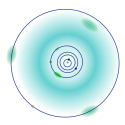1999 UJ7
| Discovery | |
|---|---|
| Discovered by | 30 October 1999 by LINEAR |
| Discovery site | Socorro |
| Discovery date | 30 October 1999 |
| Designations | |
| 2002 AC180 | |
Martian L4 
|
|
| Orbital characteristics | |
| Epoch 13 January 2016 (JD 2457400.5) | |
| Uncertainty parameter 0 | |
| Observation arc | 21861 days (59.85 yr) |
| Aphelion | 1.5843517 AU (237.01564 Gm) |
| Perihelion | 1.4644704 AU (219.08165 Gm) |
| 1.5244110 AU (228.04864 Gm) | |
| Eccentricity | 0.0393206 |
| 1.88 yr (687.47 d) | |
| 229.9277° | |
| 0° 31m 25.183s / day | |
| Inclination | 16.75044° |
| 347.37714° | |
| 48.35771° | |
| Earth MOID | 0.47372 AU (70.868 Gm) |
| Jupiter MOID | 3.49473 AU (522.804 Gm) |
| Physical characteristics | |
| Dimensions | ~1 km |
| X | |
| 16.9 | |
(121514) 1999 UJ7 is a small asteroid orbiting near the L4 point of Mars (60 degrees ahead Mars on its orbit). As of September 2011, (121514) 1999 UJ7 is the only known asteroid to orbit the leading L4 point of Mars, although at least three other asteroids orbit Mars's trailing L5 point: 5261 Eureka, (101429) 1998 VF31, and 2007 NS2. Not only does (121514) 1999 UJ7 orbit on the other side of Mars from other similar asteroids, its spectrum is different as well, which is puzzling because all of the Martian trojans seem to be in very stable orbits.
(121514) 1999 UJ7 orbits around the L4 point of Mars in a very stable orbit and is large enough that the Yarkovsky effect will not affect its orbit.
Due to similarity in the measured brightness of (121514) 1999 UJ7 with other Martian trojans, it is thought to be a small asteroid with an effective diameter on the order of 1 kilometer (0.62 mi). Its spectrum suggests that it is an X-type asteroid, which is different from 5261 Eureka and 1998 VF31, and is somewhat puzzling since different mineral compositions suggest different origins for the two groups of asteroids. The long lifetime of the orbits for these asteroids makes the possibility of one or more of them being interlopers unlikely, however. This suggests that either one or more of the Martian trojans was captured in such a way as to give it a long-term stable orbit (and it is therefore not a primordial Martian asteroid), or that some fusion or combination of previous asteroids resulted in the presently observed ones. The Yarkovsky effect may provide a potential capture mechanism but not enough is known about the shapes of these objects to provide a useful Yarkovsky model.
...
Wikipedia
